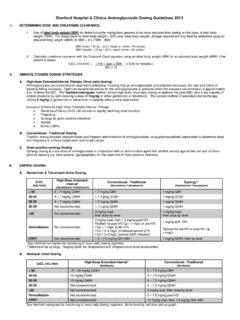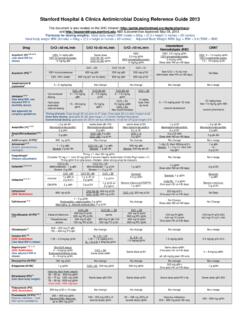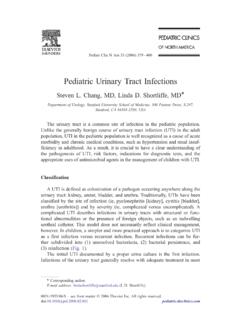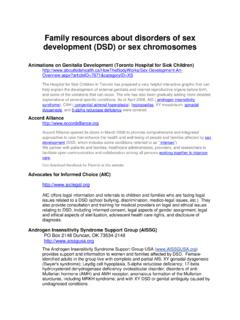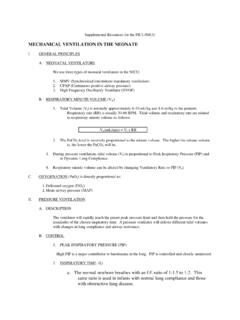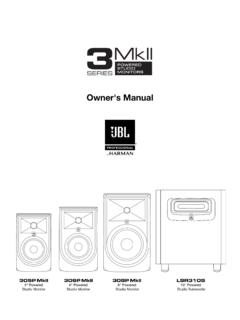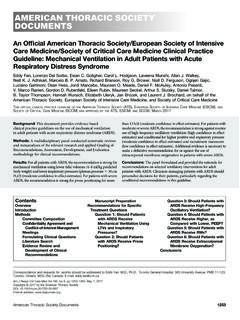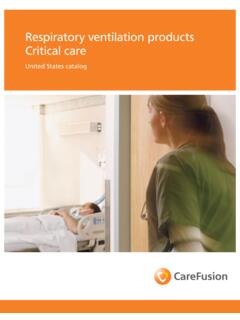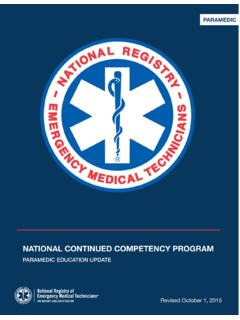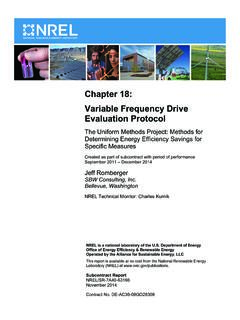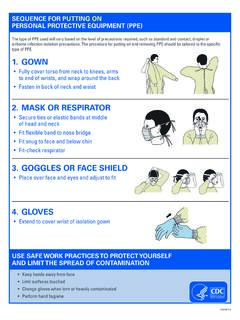Transcription of High Frequency Oscillatory Ventilation
1 high Frequency Oscillatory Ventilation (HFOV)James Xie, MDPediatric Anesthesiology FellowStanford Children s Health11/18/2019 Case Presentation- Sunday afternoon: you are called by the general surgery team for an emergent ex-lap for suspected necrotizing enterocolitis- Patient is a former 25+5 week infant born after unstoppable preterm labor, now corrected to 29+2- One day prior, patient was put on HFOV due to worsening hypercarbia (arterial PCO2 96) despite high conventional ventilator settings (Vt 5ml/kg, RR 50, PEEP 7)- Current oscillator settings are: MAP 14, Amplitude 32, Frequency 12, I-Time , FiO2 31% and recent ABG: What is your Ventilation strategy for the operation?So many did the NICU put the baby on the oscillator?
2 -Is this the same or different than high Frequency jet Ventilation ?-How does an oscillator even work?-Can you perform surgery while a patient is on the oscillator?-How do I manage an oscillator? What are all those knobs for?-Can I just switch back to a conventional ventilator?-Is the oscillator working?-Can I transport to the OR on an oscillator?-Can I use nitric oxide while on HFOV?-Can anyone help me??Indications for HFOVWhen to use Pulmonary Hypertension of the Aspiration leak syndromes: pneumothorax, pulmonary interstitial Respiratory Distress of conventional Ventilation (plateau pressures 30-35 cmH20 with tidal volumes of 5-7 ml/kg and severe respiratory acidosis, pH< ) of oxygenation ( ARDS) < 90%, < 150, despite FiO2 > 60% and optimal PEEP, index (OI) > 15 (where OI = [MAP x FiO2(%)] / PaO2)Contraindications to HFOVWhen not to use HFOV (relative contraindications) airway disease (HFOV can lead to severe air trapping if used improperly) brain injury / intracranial hypertension ( high MAP can lead to decreased venous return, reduced cerebral perfusion) compromise (especially if unresponsive to fluids/vasoactives; ).
3 Consider VA ECMO!Side Note on Jet Ventilation -HFJV = high Frequency jet Ventilation (4-11Hz RR, TV 1ml/kg)-Via a pneumatic valve, short jets of gas are released into the inspiratory circuit => expiration is passive (from elastic recoil)-HFJV is used in conjunction with conventional mechanical Ventilation , with application of PEEP (sigh breaths)-Differs from low Frequency jet which uses a manually triggered hand-held device-Topics for another day!-HFOV = high Frequency Oscillatory Ventilation (3-15Hz RR, TV 1-3ml/kg)-Via movement of an electromagnetic diaphragm or piston pump, pressure is generated in the ventilator circuit => active inspiratory and expiratory phases-No sigh breaths for alveolar recruitment - can easily de-recruit-This is what we are talking about todayHow does it work?
4 -A constant distending airway pressure is applied (MAP), over which small tidal volumes are superimposed (Power/Amplitude) at a high respiratory Frequency (measured in Hz)-Radial mixing (Taylor dispersion): enhances gas mixing with laminar flow (beyond bulk flow front)-Collateral Ventilation : alveoli communicate directly with other nearby alveoli-Coaxial flow: net flow through centre of airway on way down, then on outside of airway on way up-Pendelluft Ventilation nearby lung units have different time constants/impedance/phase lags-Cardiogenic mixing: internal wobble of heartbeats transmitted to the molecules of gas within the lungs causes gas mixingHow does it work?Image source: (HFOV)-and-a-Stawicki-Goyal/1196df59f3d6 e08db0db881e478c3a8629d43548/figure/4 Intraoperative Use of HFOV-Yes, it s been done!
5 -Conditions operated on include: congenital diaphragmatic hernia, congenital cystic adenomatoid malformation, esophageal atresia, PDA, abdominal wall defect, NEC-Advantages:-HFOV minimizes lung movement and interference with the surgical field-Provides continuity in in perioperative ventilatory management-May minimize lung injury, especially in conditions with altered respiratory compliance-Limitations:-Lack of familiarity with HFOV by anesthesiologist -Can t use inhalational agents (thus TIVA is recommended)-Routine capnography not possible (frequent blood gases, TCOM needed)-HFOV is loud and can hinder clinical exam ( auscultation of heart sounds)SensorMedics 3100A/B HFOV-3100A model: Approved by FDA in 1991 for use in neonates, used for patients < 35kg-3100B model: used for patients > 35kg-Approval for use in all pediatrics in 1995 Reasonable Starting Settings-You will likely never adjust bias flow, Frequency , or I-time:-Bias flow (allowing further increase in MAP)-< 1 year old: 15-25 L/m,-1-8-year-old: 15-30 L/m- 8-year-old: 25-40 L/m- Frequency -Preterm neonate: 15Hz (900 bpm)-Term neonate: 12Hz (720 bpm)-Infant/Child: 10Hz (600 bpm)-Older child: 8Hz (480 bpm)-Inspiratory time-Usually set to 33% (I:E ratio of 1:2)-Higher I-times may lead to air trapping-MAP (max ~ 40-45 cm H2O)-Neonates: 2-5 cm above MAP on CMV-Infants/Children.
6 5-8 cm above MAP on CMV-MAP, if starting immediately on HFOV-Neonates: 8-10 cm H20-Infants/children: 15-20 cmH20 -Amplitude/Power: adjust P until there is perceptible chest wall motion from the nipple line to the umbilicus (AKA chest wiggle factor). Initial settings might be:-Wt < kg: - kg: - kg: - kg: - 10 kg: > 20 kg: I switch to CMV?Patient may be able to tolerate conventional Ventilation if your HFOV settings are:-MAP < 16-17 cm-FiO2 < - < convert to CMV, use a MAP 3-4 cm less than the MAP on HFVHow do I know it s working?-Patient SpO2 in the first 30-60 minutes of initiation can change dynamically-Adequate jiggling / wobbling / chest wiggle = patient is being ventilated-CXR to confirm that patient is not hyperinflated (MAP too high )-Transcutaneous CO2 monitoring can help trend CO2-Be aware of changes in lung compliance ( secretions, neuromuscular blockade)-Consider suctioning +/- recruitment maneuver if O2 saturations remain low (but don t suction too much because it will de-recruit the lungs.)
7 Use a closed suction system if possible)Transcutaneous CO2 Monitoring-NICU respiratory therapists can assist with TCOM setup and use-Try to correlate with blood gas measurements to assess ventilationQuick Troubleshooting GuidePoor OxygenationOver OxygenationUnder VentilationOver VentilationIncrease FiO2 Decrease FiO2 Increase amplitudeDecrease amplitudeIncrease MAP*(1-2cmH2O)Decrease MAP(1-2cmH2O)Decrease Frequency **(1-2Hz) if amplitude Maximal Increase Frequency **(1-2Hz) if amplitude Minimal* Consider recruitment maneuvers** Changes in Frequency are rare Why decreasing Frequency increases TV-A lower Frequency means there are fewer breaths per minute-This means the absolute inspiratory time is increased-If the I:E ratio is fixed at 1:2, the delta P for a given MAP will lead to a larger tidal volume being deliveredDetailed guide for with HFOV?
8 -Can I transport with HFOV?-Sort of? - It would require multiple tanks of O2 and a battery pack. If patient is too unstable for transport, consider doing the procedure at bedside-Moving a patient while on HFOV has been described in the literature (Lee et al 2012: Using the high Frequency Ventilation during Neonatal Transport)-Can I use nitric oxide with HFOV?-Yes! This is well described, especially in the PPHN population-Kinsella et al (1997): Randomized, multicenter trial of inhaled nitric oxide and high - Frequency Oscillatory Ventilation in severe, persistent pulmonary hypertension of the newborn found that treatment with HFOV plus iNO is often more successful than treatment with HFOV or iNO alone in severe PPHN When in for help!
9 -Respiratory therapy team-RT Supervisor x 19613-OR RT on Voalte-NICU MDsSummary-HFOV is a useful ventilatory modality that can provide lung protective Ventilation /oxygenation, especially when conventional Ventilation is inadequate-HFOV can be safely and effectively continued intraoperatively-HFOV delivers an unknown tidal volume -> must check blood gases or trend TCOMs-Not wiggling = not ventilating-Higher MAP = more oxygenation-Higher amplitude (delta P or power) = more Ventilation -It is highly unlikely you will need to adjust the I-time, Frequency , or bias flow-Have a plan for transport (or not-transporting if patient is too unstable)-You can use nitric oxide, but not volatile agents. Plan on in doubt, ask for help!
10 ReferencesWibble Wobble: high Frequency Oscillatory Ventilation ( )Bouchut JC, Godard J, Claris O. high - Frequency Oscillatory Ventilation . Anesthesiology. 2004;100(4):1007-12. ( )Klein, J. Management strategies with high Frequency Oscillatory Ventilation (HFOV) in neonates using the SensorMedics 3100A high Frequency Oscillatory ventilator ( )CareFusion. 3100A high Frequency Oscillatory Ventilator Pocket Guide ( )
